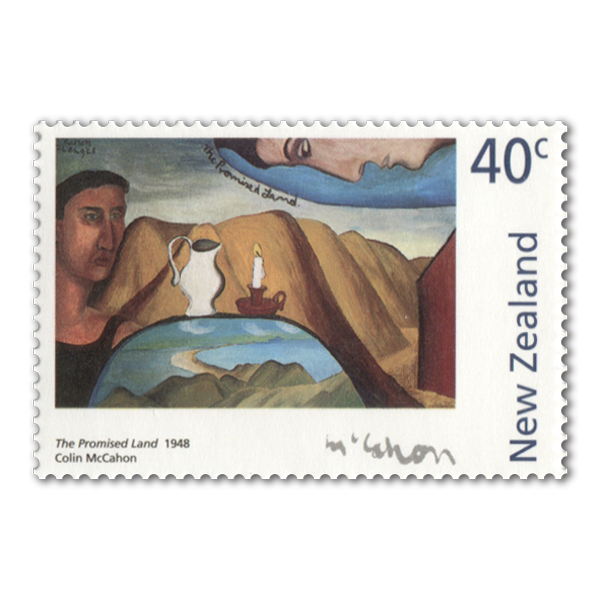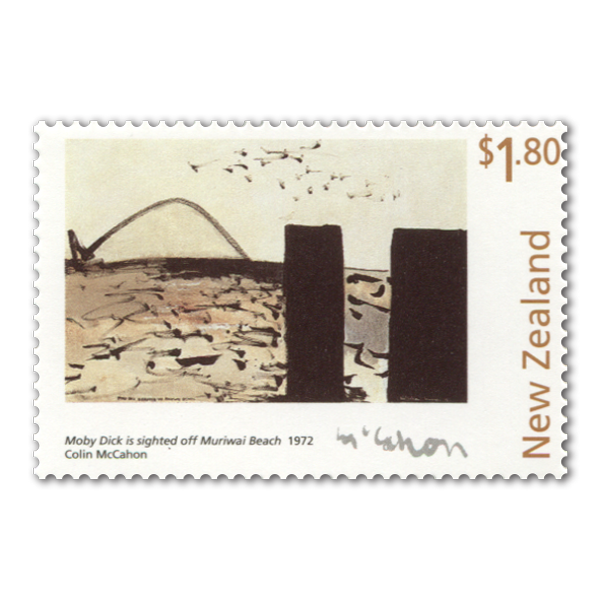Few other 20th century New Zealand painters have received the international respect and admiration that has been accorded to Colin McCahon (1919-1987). The distinctive power and originality of his images have made him a giant of New Zealand painting.
Issue information
McCahon was born in Timaru, but spent most of his life in Auckland, where he worked at the Auckland Art Gallery and taught at the Elam School of Art. He began as a landscape painter, and from this a visionary style evolved featuring the placement of religious images and words against New Zealand landscape backdrops. His painting career spanned five decades.
His desire to communicate to fellow New Zealanders through his painting was one of McCahon's central concerns. He once wrote: "As a painter I may often be more worried about you than you are about me, and if I were not concerned I'd not be doing my job properly as a painter. Painting can be a powerful way of talking."
Acknowledgements
New Zealand Post wishes to acknowledge the following for their assistance and guidance in bringing together this special stamp issue.
- The photograph that appeared on the first day cover was taken in December 1948 by Theo Schoon. Printed by permission of Anna-Maria Hertzer and Sally Schoon.
- Paintings and Colin McCahon's signature were reproduced with permission of the Colin McCahon Trust.
Product Listing for New Zealand Art - Colin McCahon
| Image | Title | Description | Price |
|---|---|---|---|
 |
Single Stamp |
Single 40c 'The Promised Land, 1948' gummed stamps. Oil on canvas, Auckland Art Gallery collection, gift of the McCahon family 1989 (1989/51/1). This painting is drawn from the period when McCahon first began to experiment in using painting as a vehicle for explicit messages, with particular emphasis on religious themes. |
$0.40 |
 |
Single Stamp |
Single $1.00 'Six Days in Nelson and Canterbury, 1950' gummed stamp. Oil on canvas on board, Auckland Art Gallery collection, gift of the Friends of the Auckland Art Gallery 1978 (1978/12). It was during the 1950s that the 'McCahon style' became firmly established. This was one of a number of paintings from this, and later periods, that deals with revelation and discovery of New Zealand through an imaginary journey into the landscape. |
$1.00 |
 |
Single Stamp |
Single $1.50 'Northland Panels, 1958 (detail)' gummed stamp. Oil-based house paints on unstretched canvas, Museum of New Zealand Te Papa Tongarewa collection (B41188). McCahon and his wife travelled to the United States in 1958. This exposure to fresh and exciting visual stimuli became immediately evident in the scale and ambition of his work, with the Northland Panels being one example. |
$1.50 |
 |
Single Stamp |
Single $1.80 'Moby Dick is Sighted off Muriwai Beach, 1972' gummed stamp. Acrylic on canvas, Museum of New Zealand Te Papa Tongarewa collection (B385668). One of McCahon's studios was located at Muriwai. The changing moods of this west Auckland beach, with its dramatic cliffs and gannet sanctuary, inspired much of his work during the 1970s. Here, McCahon imagines Oaia Island, which lies off Muriwai Beach, as Herman Melville's great white whale, Moby Dick. |
$1.80 |
 |
First Day Cover | First day cover with stamps affixed. Cancelled on the first day of issue. | $5.20 |
Technical information
| Date of issue: | 7 May 1997 |
|---|---|
| Stamps and first day cover designed by: | Hamish Thompson, Wellington, New Zealand |
| Number of stamps: | Four |
| Denominations and designs: | 40c The Promised Land, 1948; $1.00 Six Days in Nelson and Canterbury, 1950; $1.50 Northland Panels, 1958 (detail); $1.80 Moby Dick is Sighted off Muriwai Beach, 1972 |
| Printer and process: | Southern Colour Print, Dunedin, New Zealand by lithography |
| Number of colours: | Four process colours, plus one special colour per denomination |
| Stamp size: | 44.28mm x 30mm (horizontal) |
| Number of stamps per sheet: | 100 |
| Perforation gauge: | 14 |
| Paper type: | 103gsm red phosphor coated gummed stamp paper |
| Cost of unadressed first day cover: | $5.20 |
| Special blocks: | Plate/imprint, positional or value blocks could be obtained by purchasing at least six stamps. |
| Colour blocks: | Also known as 'traffic lights', these blocks were included in plate blocks. |
| Barcode blocks: | Barcode blocks were available in both A and B formats. |
| Special 'artist information' blocks: | These blocks, which contained the credits and copyright for the painting depicted, could be obtained by purchasing at least six stamps. |
| Period of sale: | These stamps remained on sale until 7 May 1998. |


